Key takeaways:
- Culinary education emphasizes understanding food culture, history, and sustainability while fostering creativity and critical thinking.
- Regional spices enhance flavors and preserve cultural traditions, connecting individuals to their heritage and ancestry.
- Cooking techniques such as toasting spices and timing their addition can significantly elevate the complexity and depth of dishes.
- Exploration of spices encourages experimentation and balance, revealing how a single ingredient can transform meals and evoke memories.
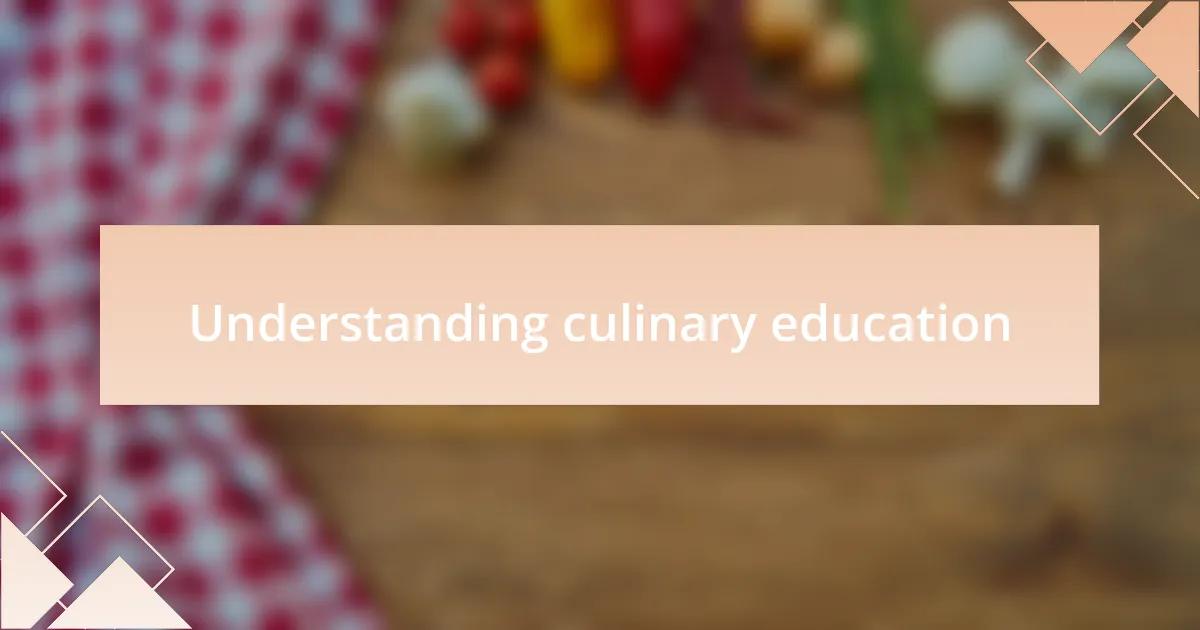
Understanding culinary education
Culinary education is more than just learning to cook; it’s about cultivating a deep understanding of food, culture, and technique. I remember my own culinary classes where we didn’t just chop vegetables; we discussed the history behind each ingredient. Have you ever thought about how our food choices reflect our heritage and identity?
As I progressed through my culinary journey, I realized that education in this field fosters creativity and critical thinking. I often found myself experimenting with regional spices, driven by both tradition and innovation. Isn’t it fascinating how a single ingredient can connect you to different cultures around the world?
Through culinary education, we also learn about the science of cooking, the importance of sustainability, and the impact of our culinary decisions on the environment. I often grapple with the balance between indulgence and health in my cooking, and this journey has shaped not just my skills, but also my values. How do you see your culinary journey evolving as you embrace these aspects of education?
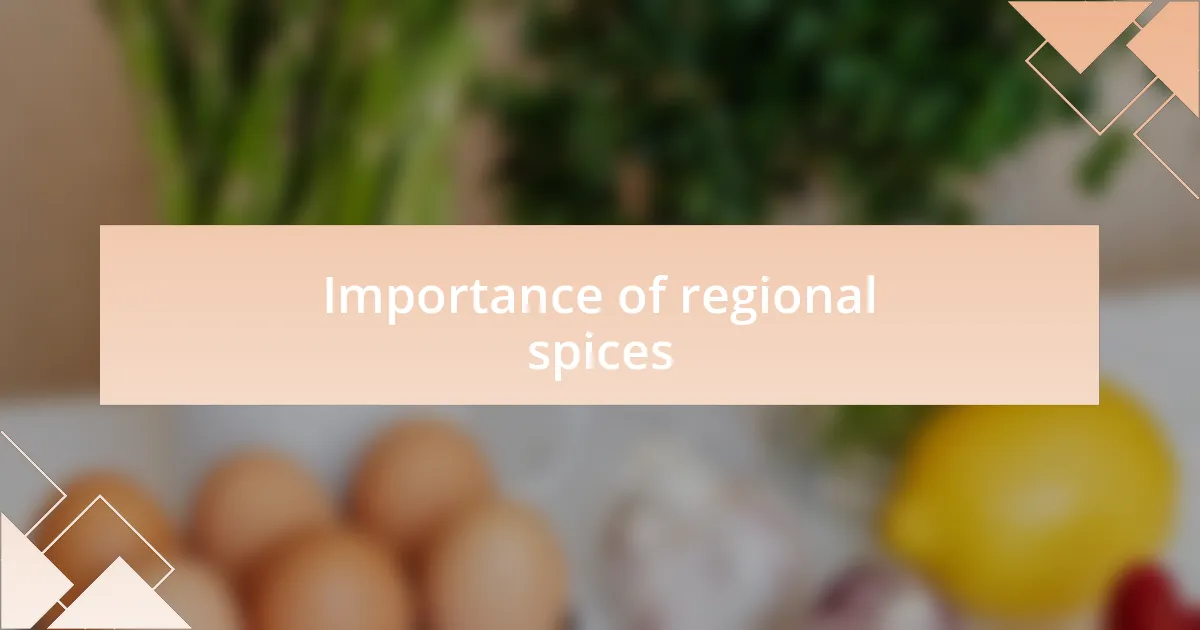
Importance of regional spices
Regional spices play a crucial role in highlighting the essence of local cuisines. When I first encountered a Moroccan spice mix, I was captivated by how each aromatic component told a story of the land and its people. Isn’t it amazing how a sprinkle of za’atar can transport you to the bustling bazaars of Marrakech?
The uniqueness of regional spices not only enhances flavor but also preserves cultural traditions. I recall a family gathering where my grandmother shared her cherished recipes, enriched with spices passed down through generations. Isn’t it interesting how these flavors serve as a bridge connecting us to our ancestry?
Moreover, understanding the significance of regional spices deepens our culinary knowledge. The more I experimented with spices like sumac or garam masala, the more I appreciated their health benefits and culinary versatility. How often do we consider that a familiar spice can enhance our dishes while also contributing to our well-being?
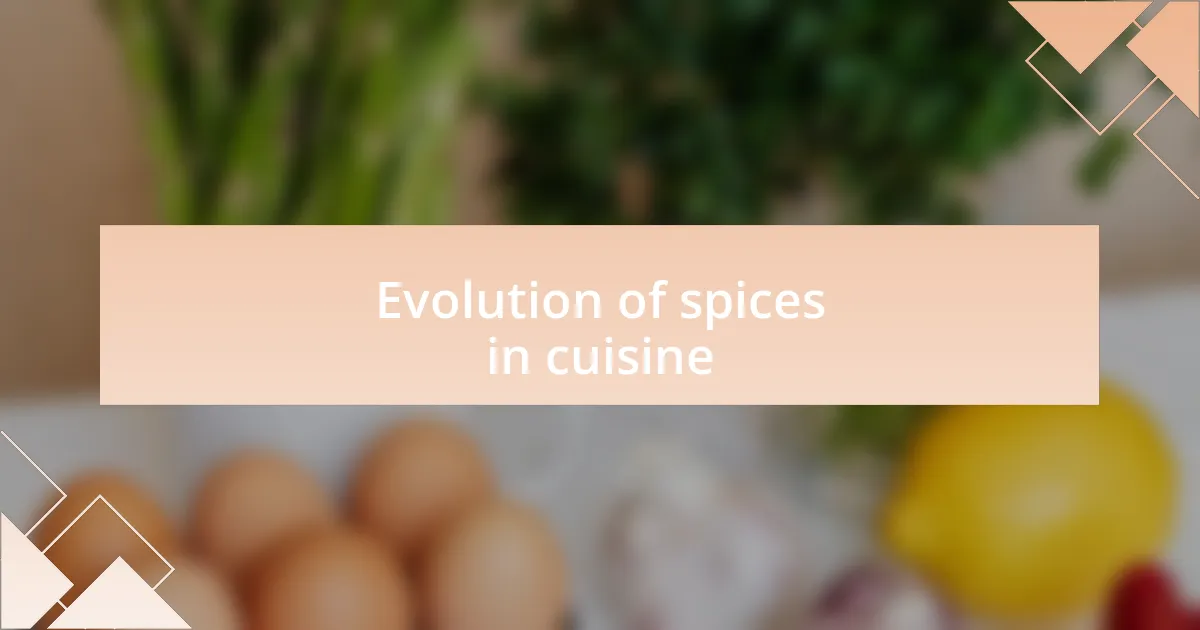
Evolution of spices in cuisine
Spices have not only transformed taste but also shaped culinary practices throughout history. For instance, when I first learned about the Silk Road’s impact, I realized how spices like pepper and cinnamon were once as valuable as gold, traded across continents. Isn’t it fascinating how what began as a means of preservation has evolved into a celebratory feature of global cuisines?
In my exploration of spices, I’ve come to recognize how they have the power to define regional dishes. I remember trying a homemade curry that was infused with cardamom and cloves; the aroma alone had the ability to pull everyone into the kitchen, eager to savor the final dish. This experience made me reflect: how many different traditions can one spice connect?
As I delved deeper into spice blending, the evolution of these flavors became clearer. I often find myself recreating an old family recipe, adapting it with contemporary spices like smoked paprika or harissa. It’s empowering to think that as our palates evolve, so too does the way we celebrate and share food. Have you ever wondered how a simple dish can become a canvas for creativity through the evolution of spices?
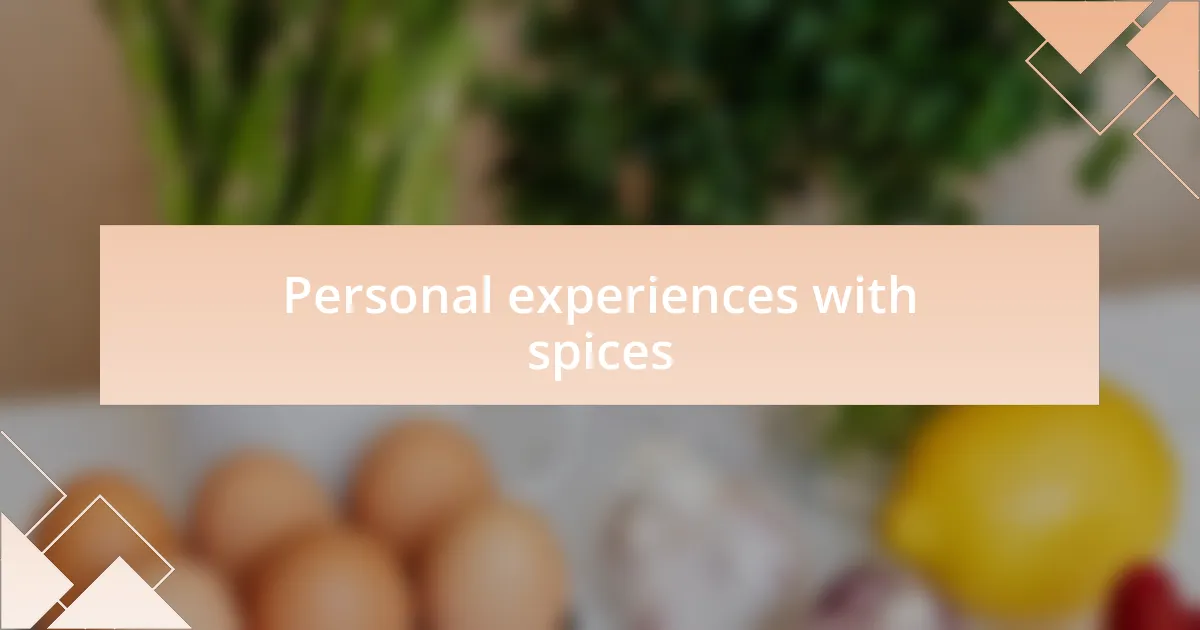
Personal experiences with spices
I recall my first encounter with saffron at a local market, where its vibrant color and unique aroma instantly captivated me. The vendor’s passion for this delicate spice was infectious, and I felt a spark of curiosity ignite within me. I ended up purchasing a small amount, and as I later infused it into a risotto, I realized that spices can literally transform a dish and elevate it into something extraordinary.
Another memorable experience was preparing a family dinner with a blend of spices from different cultures. I decided to incorporate sumac, a tangy spice I had just discovered, into a traditional West Asian dish. The burst of flavor brought forth a new appreciation for the versatility of regional spices and how they can cross culinary boundaries. Have you ever experienced a moment when a simple ingredient turned a meal into a conversation piece?
Recently, I embarked on a journey to recreate my grandmother’s secret spice mix, a cherished family tradition passed down through generations. Each taste I experimented with brought back fond memories of family gatherings and laughter. This personal adventure reminded me that spices are not just seasonings; they are carriers of stories and nostalgia, weaving personal histories into every bite. How do your favorite spices shape your culinary journey?
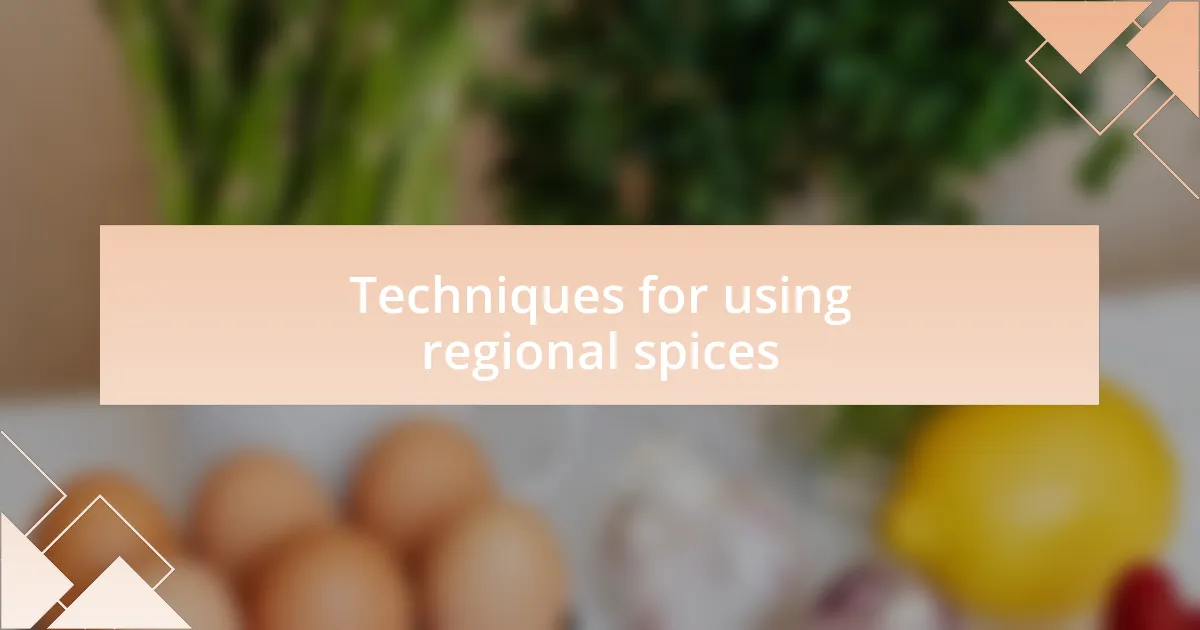
Techniques for using regional spices
When using regional spices, the art of toasting can unlock an entirely new dimension of flavor. I vividly remember the first time I heated cumin seeds in a dry pan; the release of their rich, nutty aroma took me by surprise. Have you ever noticed how a simple technique like this can change the character of a dish? By engaging in this technique, not only do you enhance the spices’ flavors, but you also connect with the aromatic traditions of various cultures.
Incorporating spices during different cooking stages can also make a significant difference. I learned this while preparing a curry; adding cardamom early on allowed its essence to permeate the dish, creating depth. It’s fascinating how the timing of spice addition can impact your meal’s complexity. Have you experimented with layering spices? I believe it’s one of the secrets to achieving a harmonious balance in any recipe.
Another delightful revelation for me has been the emphasis on pairing spices with the right ingredients. Combining turmeric with black pepper not only boosts the color of a dish but also increases the absorption of curcumin, turmeric’s beneficial compound. When I realized this, it changed how I approached healthy cooking. What unique spice pairings have you discovered that turned an ordinary dish into something unforgettable?

Recipes featuring regional spices
Experimenting with regional spices can transform even the simplest recipes into culinary masterpieces. A few years back, I decided to make a classic Mediterranean ratatouille, but instead of just relying on the usual herbs, I incorporated za’atar. The result was a vibrant dish bursting with flavor and warmth, and I could hardly contain my excitement when I served it to friends who were pleasantly surprised by the twist. Have you ever tried to elevate a familiar dish by introducing a spice that became its star?
For a more personal touch, consider a warming Moroccan tagine, which relies heavily on the perfect blending of spices like cinnamon and saffron. I recall the first time I prepared it; the kitchen filled with a sweet and savory aroma reminiscent of a bustling market. The spices mingled beautifully with the tender meat and vegetables, creating layers of flavor that delighted everyone at the table. Isn’t it incredible how a single spice can bring back memories and evoke emotions tied to a particular culture?
Lastly, there’s something magical about using smoked paprika in a Spanish paella. I remember feeling skeptical at first because I wasn’t familiar with how it differed from regular paprika. Once I tasted the dish, though, it was like opening a door to a vibrant culinary world. The smokiness added depth that was nothing short of transformative. How have you seen spices like this elevate your culinary adventures?

Lessons learned from spice exploration
Exploring regional spices has taught me that every spice tells a story, not just of taste but of culture and tradition. I vividly recall trying sambal from Indonesia for the first time; its fiery kick was a revelation. It reminded me that food is a bridge to understanding the world—how often do we let a spice open up a conversation about its origins and the people who use it daily?
One essential lesson learned is to embrace the unknown and be open to experimentation. I once ventured to combine cardamom—usually reserved for desserts—with a savory curry. The combination surprised my palate and elevated the dish in ways I never anticipated. Have you had that moment when you discover that daring to stray from the expected path leads to delicious surprises?
Through my spice journey, I’ve come to appreciate the power of balance. When I first played with the bold flavors of harissa in a roasted vegetable salad, I realized that a little goes a long way. It’s taught me that cooking is not just about adding more, but also about finding harmony among flavors. How often do we consider the balance of spices as a crucial part of our culinary creations?